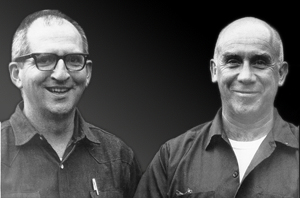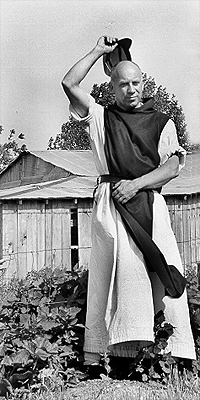Thomas Merton (1915-1968) is arguably the most influential American Catholic author of the twentieth century. His autobiography, The Seven Storey Mountain, has sold over one million copies and has been translated into over fifteen languages. He wrote over sixty other books and hundreds of poems and articles on topics ranging from monastic spirituality to civil rights, nonviolence, and the nuclear arms race.
Thomas Merton was born in Prades, France. His New Zealand-born father, Owen Merton, and his American-born mother, Ruth Jenkins, were both artists. They had met at painting school in Paris, were married at St. Anne's Church, Soho, London and returned to the France where Thomas Merton was born on January 31st, 1915.
After a rambunctious youth and adolescence, Merton converted to Roman Catholicism whilst at Columbia University and on December 10th, 1941 he entered the Abbey of Gethsemani, a community of monks belonging to the Order of Cistercians of the Strict Observance (Trappists), the most ascetic Roman Catholic monastic order.
The twenty-seven years he spent in Gethsemani brought about profound changes in his self-understanding. This ongoing conversion impelled him into the political arena, where he became, according to Daniel Berrigan, the conscience of the peace movement of the 1960's. Referring to race and peace as the two most urgent issues of our time, Merton was a strong supporter of the nonviolent civil rights movement, which he called "certainly the greatest example of Christian faith in action in the social history of the United States." For his social activism Merton endured severe criticism, from Catholics and non-Catholics alike, who assailed his political writings as unbecoming of a monk.
During his last years, he became deeply interested in Asian religions, particularly Zen Buddhism, and in promoting East-West dialogue. After several meetings with Merton during the American monk's trip to the Far East in 1968, the Dali Lama praised him as having a more profound understanding of Buddhism than any other Christian he had known. It was during this trip to a conference on East-West monastic dialogue that Merton died, in Bangkok on December 10, 1968, the victim of an accidental electrocution. The date marked the twenty-seventh anniversary of his entrance to Gethsemani.
A CHRONOLOGY OF THOMAS MERTON'S LIFE & PUBLICATIONS
 Brother Patrick Hart,. Merton's last secretary, and Thomas Merton. Photography by Philip Stark. S.J. | 1915 - January 31-born at Prades, France, son of Owen Merton (artist from New Zealand) and of Ruth Jenkins (artist from USA) 1916 - moved to USA, lived at Douglaston, L.I. (with his mother's family) 1921 - his mother dies-from cancer 1922 - in Bermuda with his father who went there to paint 1925 - to France with his father, lived at St. Antonin 1926 - entered Lycee Ingres, Montauban, France 1928 - to England-Ripley Court school, then to Oakham (1929) 1931 - his father dies of a brain tumor 1932 - at Oakham School he acquired a scholarship to Clare College, Cambridge 1933 - visited Italy, spent summer in USA, entered Cambridge in the fall - study of modern languages (French and Italian) 1934 - left Cambridge and returned to USA 1935 - entered Columbia University 1937 - at Columbia - editor of the 1937 Yearbook and art editor of the Columbia Jester 1938 - graduated from Columbia, began work on M.A. 1938 - November 16 - received into the Catholic Church at Corpus Christi Church 1940 - 1941 - taught English at St. Bonaventure College 1941 - December 10-entered the Abbey of Our Lady of Gethsemani, Trappist, Kentucky. |
[Note: January 31, 1915 to December 10, 1941-nearly 27 years before entering monastery. Dies on December 10, 1968-the 27th anniversary of his entering Gethsemani.]
| 1944 - March 19 - made simple vows, published Thirty Poems 1946 - A Man in the Divided Sea 1947 - March 19 - solemn vows, published Exile Ends in Glory 1948 - Publication of best-seller autobiography, The Seven Storey Mountain and What Are These Wounds? 1949 - May 26 - ordained priest; Seeds of Contemplation; The Tears of the Blind Lions; The Waters of Siloe 1951 - 1955 - Master of Scholastics (students for priesthood) 1951 - The Ascent to Truth 1953 - The Sign of Jonas; Bread in the Wilderness 1954 - The Last of the Fathers 1955 - No Man Is an Island 1955 - 1965 - Master of Novices 1956 - The Living Bread 1957 - The Silent Life; The Strange Islands 1958 - Thoughts in Solitude 1959 - The Secular Journal of Thomas Merton; Selected Poems 1960 - Disputed Questions; The Wisdom of the Desert 1961 - The New Man; The Behavior of Titans 1961 - Emblems of a Season of Fury; Life and Holiness; 1964 - Seeds of Destruction 1965 - Gandhi on Non-Violence; The Way of Chuang Tzu; Seasons of Celebration 1965 - 1968 - lived as a hermit on the grounds of the monastery 1966 - Raids on the Unspeakable; Conjectures of a Guilty Bystander 1967 - Mystics and Zen Masters 1968 - Monks Pond; Cables to the Ace; Faith and Violence; Zen and the Birds of Appetite 1968 - December 10-died at Bangkok, Thailand, where he had spoken at a meeting of Asian Benedictines and Cistercians. |  Photograph by Ralph Eugene Meatyard. Copyright the Meatyard Estate. |
 Photograph of Merton by John Lyons. | Posthumous Publications: 1969 - My Argument with the Gestapo; Contemplative Prayer; The Geography of Lograire 1971 - Contemplation in a World of Action 1973 - The Asian Journal of Thomas Merton; He Is Risen 1976 - Ishi Means Man 1977 - The Monastic Journey; The Collected Poems of Thomas Merton 1979 - Love and Living 1980 - The Non-Violent Alternative 1981 - The Literary Essays of Thomas Merton; Day of a Stranger Introductions East and West: The Foreign Prefaces of Thomas Merton (reprinted in 1989 under title "Honorable Reader" Reflections on My Work) 1982 - Woods, Shore and Desert: A Notebook, May 1968 1985 - The Hidden Ground of Love: Letters on Religious Experience and Social Concerns (Letters, 1) 1988 - A Vow of Conversation: Journals 1964-1965; Thomas Merton in Alaska: The Alaskan Conferences, Journals and Letters 1989 - The Road to Joy: Letter to New and Old Friends (Letters, II) 1990 - The School of Charity: Letters on Religious Renewal and Spiritual Direction (Letters, III) 1993 - The Courage for Truth: Letters to Writers (Letters, IV) 1994 - Witness to Freedom: Letters in Times of Crisis (Letters, V) 1995 - Run to the Mountain: The Story of a Vocation (Journals, I: 1939-1941) 1996 - Entering the Silence: Becoming a Monk and Writer (Journals, II: 1941-1952); A Search for Solitude: Pursuing the Monk's True Life (Journals, III: 1952-1960); Turning Toward the World: The Pivotal Years (Journals, IV: 1960-1963) 1997 -Dancing in the Water of Life: Seeking Peace in the Hermitage (Journals, V: 1963- 1965); Learning to Love: Exploring Solitude and Freedom (Journals VI: 1966-1967) 1998 -The Other Side of the Mountain: The End of the Journey (Journals VII: 1967-196 1999 -The Intimate Merton: His Life from His Journals 2001 - Dialogues with Silence. 2003 - The Inner Experience. Seeking Paradise: The Spirit of the Shakers. 2004 - Peace in a Post-Christian Era. 2005 - In the Dark Before Dawn: New Selected Poems of Thomas Merton. Cassian and the Fathers. 2006 - The Cold War Letters. Pre-Benedictine Monasticism. 2008 - Introduction to Christian Mysticism. 2009 - The Rule of St. Benedict. Compassionate Fire: The Letters of Thomas Merton and Catherine De Hueck Doherty. 2010 - Monastic Observances. |
Bibliography:
Marquita E. Breit and Robert E. Daggy, Thomas Merton: A Comprehensive Bibliography (Garland, 1986)
Marquita E. Breit, Patricia A. Burton and Paul M. Pearson, ‘About Merton’: Secondary Sources 1945-2000: A Bibliographic Workbook (2002)
Patricia A. Burton. More Than Silence: A Bibliography of Thomas Merton (Scarecrow Press, 2008)
No comments:
Post a Comment